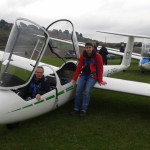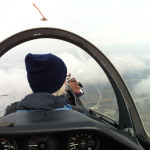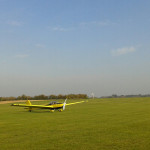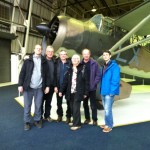Deaf Pilots met up at London Gliding Club, Dunstable over the weekend 10th-11th October 2015.
On Saturday the sky was grey with a lot of low cloud (it didn’t help that Dunstable is 500 ft above sea level) so the club’s Robin 400 Tugs were busy towing gliders between the cloud gaps.
First to launch was Rodney and John but the cloud thickened up and we had to release at 1,000ft when we entered cloud. 🙁
A little while later Joan and John had an another try and we couldn’t believe our luck when a lee wave cloud gap appeared over the new Dunstable bypass. Nicola our tug pilot towed us to the upwind edge of the cloud and immediately after release we found some weak wave lift. Thanks Nicola! We spent about 25 minutes beating up and down the upwind edge of the cloud and eventually had to return to the club only to find that everyone had gone for lunch. They missed the best part of the day!
After lunch Dave had a quick check flight and then went off to fly a ASK23 solo. Rodney had his second flight and this time we succeeded in getting a bit higher. Rodney practiced flying in the low tow position and recovering out from the lateral position.
Soon it was getting dark and time to put the gliders away in the hangar then we off we went for a pub dinner.
Sunday was much better with less cloud but visibility was still poor.
First to fly was Tim and John in the SF25C motor-glider whilst Tim tried some specially modified headsets to see if he could listen to the radio with his hearing aids.
David flew the K23 and Joan and Rodney flew the ASK 21s again. We even managed to persuade Tim’s Dad to have a flight in a glider.
Many thanks to all that came and those at London Gliding Club that made us welcome.
Deaf pilots are hoping to meet up at another museum over the winter and visit a new flying club early in 2016.






